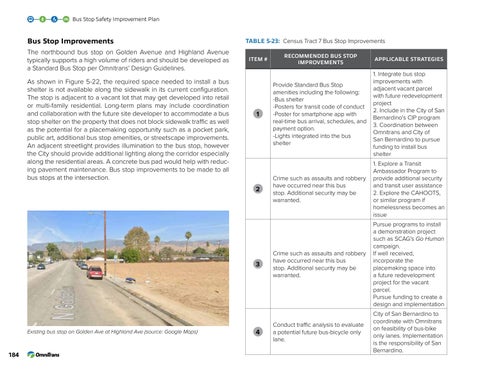Bus Stop Safety Improvement Plan
Bus Stop Improvements The northbound bus stop on Golden Avenue and Highland Avenue typically supports a high volume of riders and should be developed as a Standard Bus Stop per Omnitrans’ Design Guidelines. As shown in Figure 5-22, the required space needed to install a bus shelter is not available along the sidewalk in its current configuration. The stop is adjacent to a vacant lot that may get developed into retail or multi-family residential. Long-term plans may include coordination and collaboration with the future site developer to accommodate a bus stop shelter on the property that does not block sidewalk traffic as well as the potential for a placemaking opportunity such as a pocket park, public art, additional bus stop amenities, or streetscape improvements. An adjacent streetlight provides illumination to the bus stop, however the City should provide additional lighting along the corridor especially along the residential areas. A concrete bus pad would help with reducing pavement maintenance. Bus stop improvements to be made to all bus stops at the intersection.
Table 5-23: Census Tract 7 Bus Stop Improvements ITEM #
1
2
3
Existing bus stop on Golden Ave at Highland Ave (source: Google Maps)
184
4
RECOMMENDED BUS STOP IMPROVEMENTS
APPLICABLE STRATEGIES
Provide Standard Bus Stop amenities including the following: -Bus shelter -Posters for transit code of conduct -Poster for smartphone app with real-time bus arrival, schedules, and payment option. -Lights integrated into the bus shelter
1. Integrate bus stop improvements with adjacent vacant parcel with future redevelopment project 2. Include in the City of San Bernardino’s CIP program 3. Coordination between Omnitrans and City of San Bernardino to pursue funding to install bus shelter
Crime such as assaults and robbery have occurred near this bus stop. Additional security may be warranted.
1. Explore a Transit Ambassador Program to provide additional security and transit user assistance 2. Explore the CAHOOTS, or similar program if homelessness becomes an issue
Crime such as assaults and robbery have occurred near this bus stop. Additional security may be warranted.
Pursue programs to install a demonstration project such as SCAG’s Go Human campaign. If well received, incorporate the placemaking space into a future redevelopment project for the vacant parcel. Pursue funding to create a design and implementation
Conduct traffic analysis to evaluate a potential future bus-bicycle only lane.
City of San Bernardino to coordinate with Omnitrans on feasibility of bus-bike only lanes. Implementation is the responsibility of San Bernardino.



















































